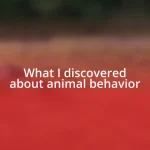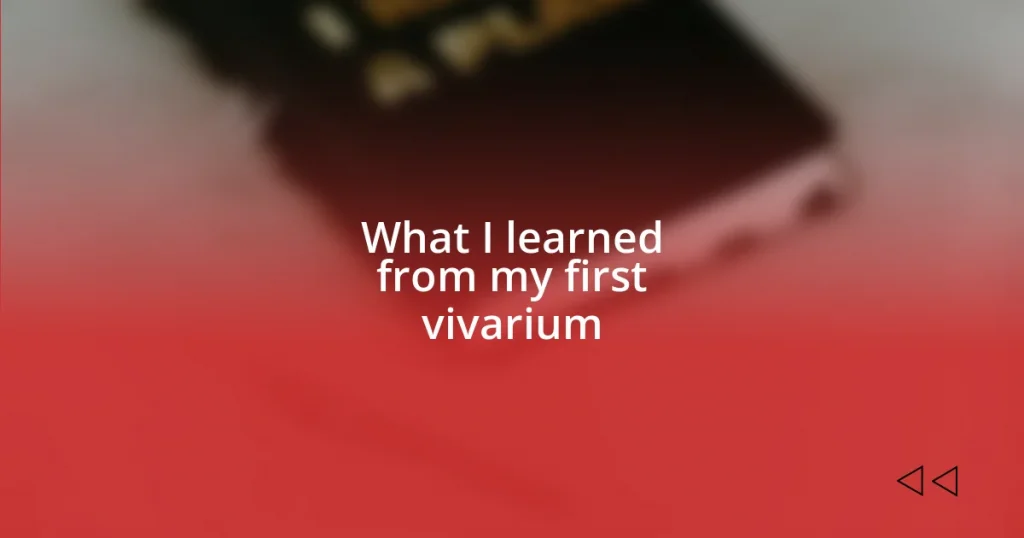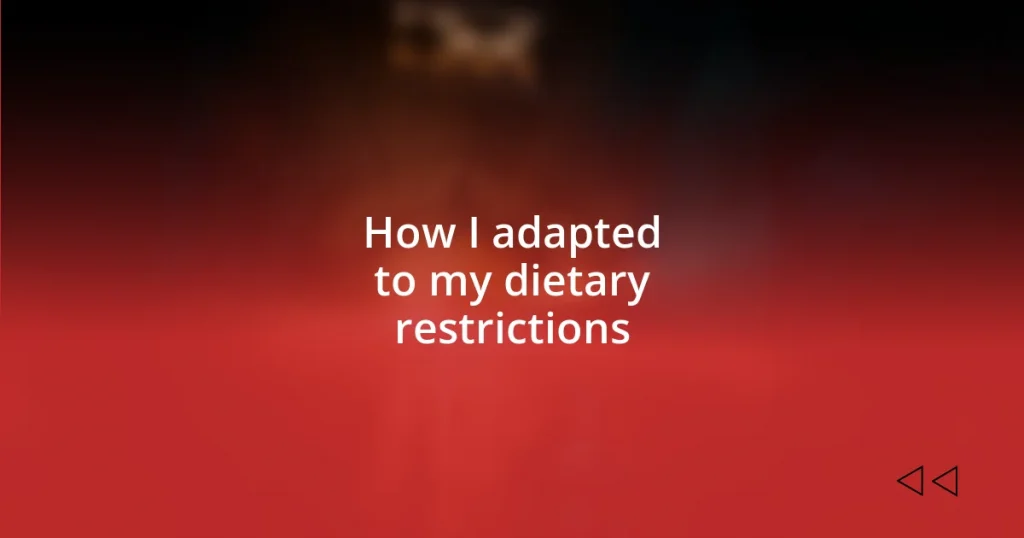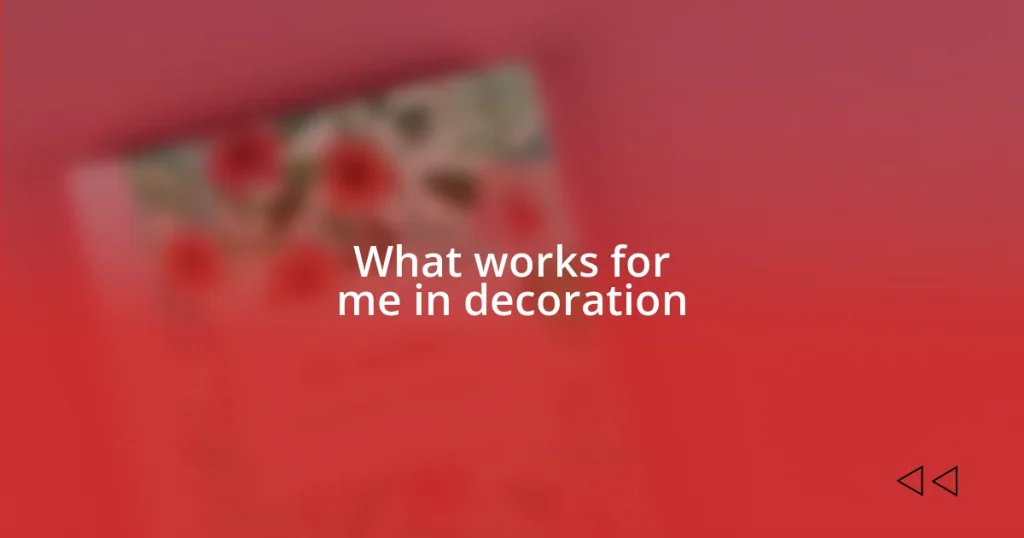Key takeaways:
- Understanding the delicate balance of species interactions is essential for creating a successful vivarium ecosystem.
- Choosing appropriate plants and animals, considering their compatibility and environmental needs, is critical for long-term health and stability.
- Consistent observation and maintenance, along with community engagement, enhance the experience and effectiveness of managing a vivarium.
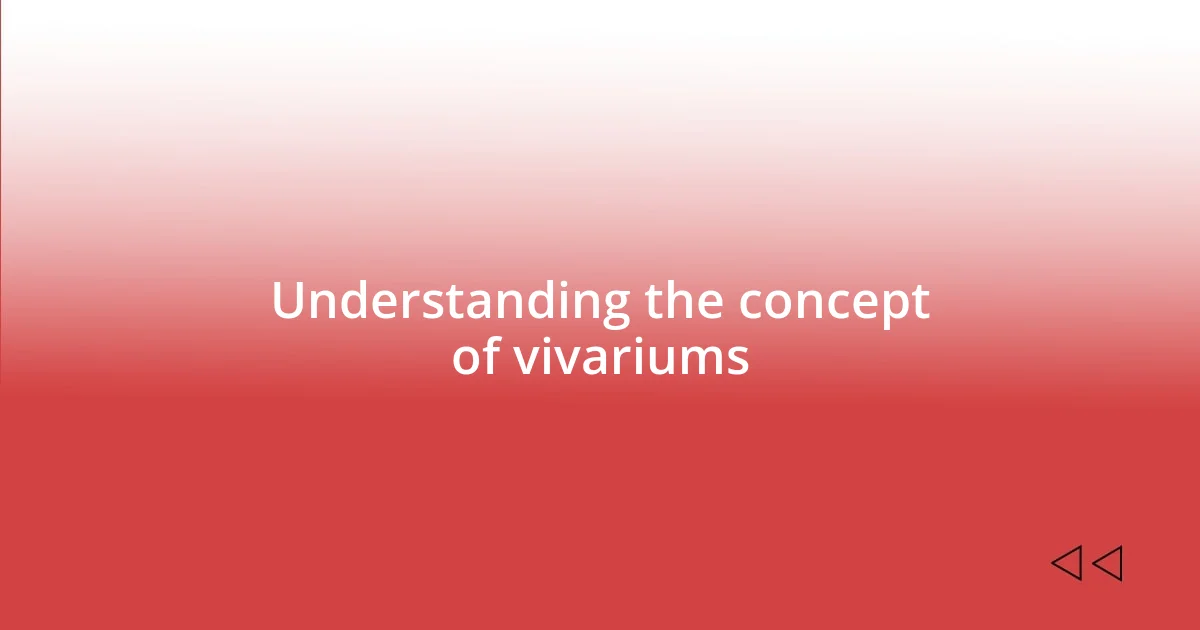
Understanding the concept of vivariums
When I first encountered the term “vivarium,” I was struck by its meaning—essentially, a controlled environment meant to mimic natural habitats. I still remember the excitement I felt at the thought of recreating an ecosystem right in my own home. Isn’t it fascinating how these spaces can support both flora and fauna together?
In my early days of maintaining a vivarium, I learned that it isn’t just about housing plants and animals; it’s about balancing the delicate interactions between different species. I remember watching my plants thrive, only to feel a pang of disappointment when a new critter disrupted that balance. It made me realize the profound responsibility we have when we attempt to replicate nature.
Setting up a vivarium isn’t just a science project; it’s an ongoing journey of observation and learning. I’ve often found myself transfixed, watching small changes—the way light filters through the leaves or how moisture collects on the glass. Have you ever noticed how something as simple as a water droplet can spark the imagination and connect us deeper to nature? Understanding vivariums goes beyond aesthetics; it’s about nurturing a living microcosm that reflects the beauty and complexity of our natural world.
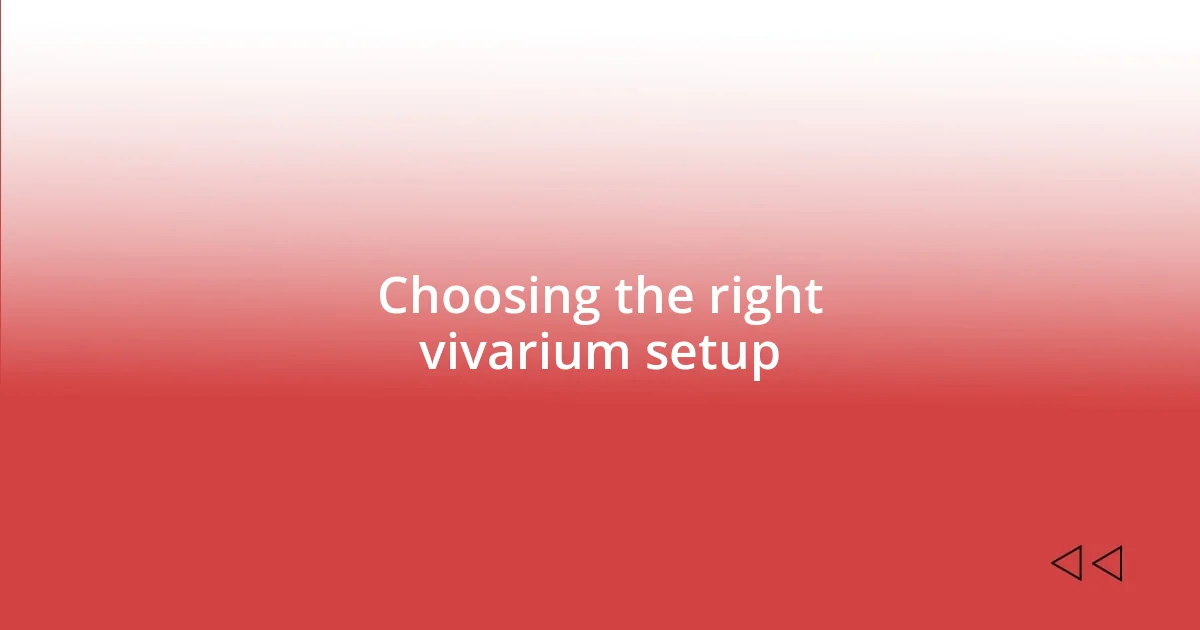
Choosing the right vivarium setup
When choosing the right vivarium setup, I found it crucial to consider the species I wanted to house. Initially, I excitedly dove into setting up my new space, only to realize that not all critters cohabitate harmoniously. Each species has specific needs—humidity levels, temperature ranges, and space requirements—so I recommend doing thorough research on each before committing to an ecosystem. For example, I made the mistake of placing a dart frog with a plant that thrived in dry conditions, which led to quite the unfortunate scenario.
Another aspect to focus on is the size of the vivarium. I remember my first setup, which was on the smaller side, and I quickly discovered that it limited my choices for plants and animals. Larger vivariums not only provide more options but also allow for better environmental stability, which is essential for maintaining healthy conditions for its inhabitants. It’s like creating a mini planet—I wanted to give my critters enough room to explore and flourish.
Lastly, the materials used in constructing the vivarium can profoundly impact the ecosystem’s success. While glass offers a chic look, I found that acrylic options can be lighter and less prone to shattering. Additionally, ventilation is a biggie; I learned the hard way that proper airflow prevents mold growth, which can harm both plants and animals. Keep in mind that choosing the right vivarium setup involves not just aesthetics but also practical considerations that affect the wellbeing of all living things within.
| Consideration | Details |
|---|---|
| Species Selection | Research species needs for successful cohabitation. |
| Size | Choose larger vivariums for better environment stability. |
| Materials | Consider acrylic for safety, and prioritize good ventilation. |
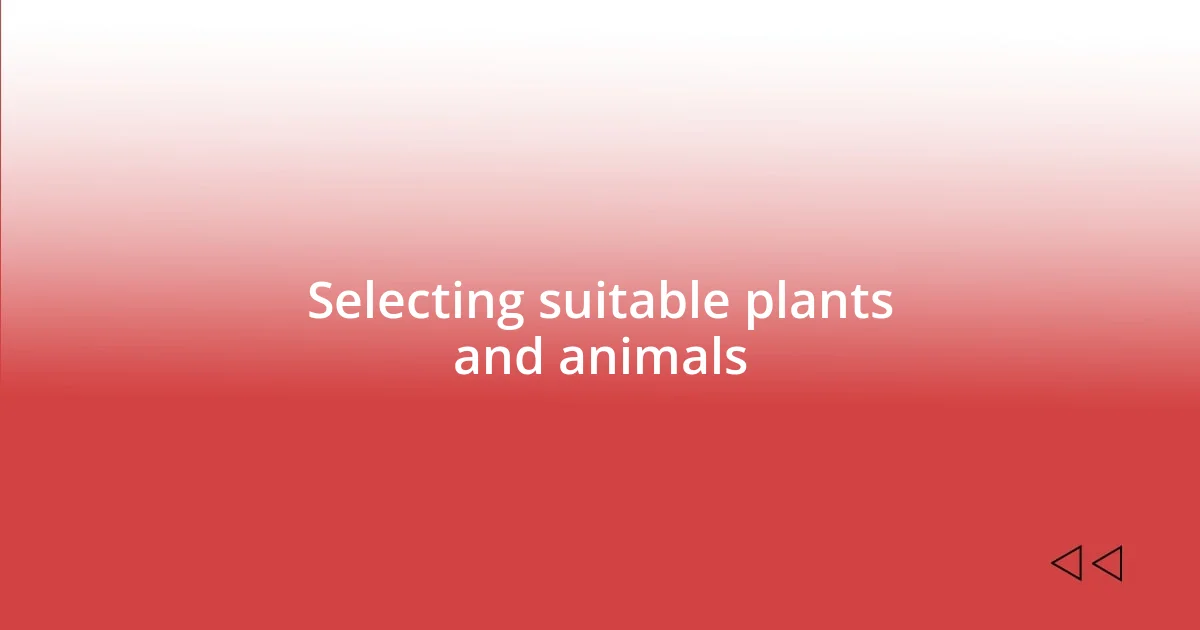
Selecting suitable plants and animals
Selecting suitable plants and animals is a critical step in creating a thriving vivarium. I recall the excitement I felt as I browsed through tropical plants and tiny critters, each one calling to me like an invitation to explore. However, it quickly became clear that not all plants and animals are compatible. I learned the hard way after adding a beautiful, vibrant plant that thrived in moisture and humidity, only to realize later that the reptile I chose needed a totally different environment. That experience taught me how vital it is to align the specific needs of each organism with what I was offering.
To make the right selection, here are a few essential points to consider:
- Compatibility: Research how various species interact before introducing them to your vivarium.
- Environmental Needs: Understand light, humidity, and temperature requirements for both plants and animals.
- Plant Choices: Opt for plants that not only complement the aesthetic but also serve the ecosystem (like providing shelter or food).
- Availability of Resources: Ensure you can sustain the needs of the selected species over time, including food, space, and care.
I often think back to those early days and the balance of joy and anxiety I experienced with each new addition I made. The more I understood their needs and behaviors, the more rewarding this journey became. It’s a continuously evolving learning process, and every choice sends ripples throughout the ecosystem I’ve created, ultimately shaping a vibrant miniature world.
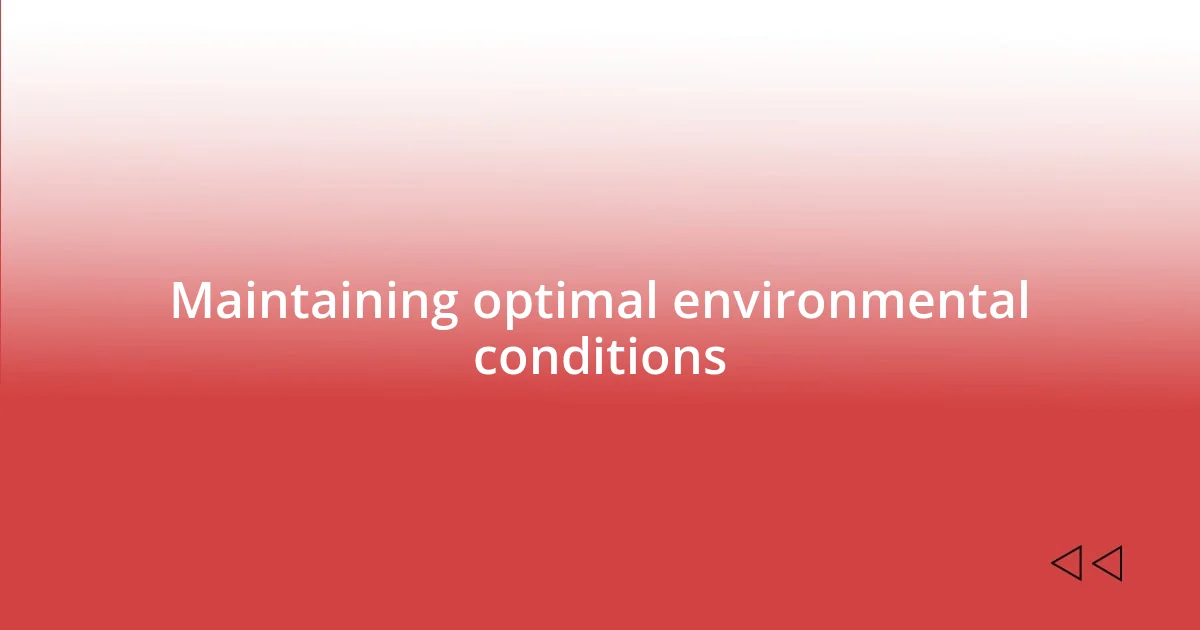
Maintaining optimal environmental conditions
Maintaining optimal environmental conditions in a vivarium is a balancing act that I learned takes diligence and keen observation. For instance, I remember my first attempt at heating—my thermometer read a comfortable temperature, but when I checked on my inhabitants, the little ones seemed lethargic. It clicked in that moment: not everything is as it seems. I soon realized how crucial it is to regularly monitor not just the current temperature but also the substrate and air quality. It’s a reminder that a healthy environment is often invisible until it’s too late.
Humidity management has also been a game changer for me. In the beginning, I thought a simple misting would suffice, but I found the delicate dance between too much and too little humidity can make or break the environment. I invested in a hygrometer, and watching those numbers shift became almost like reading a living map of my ecosystem. Sometimes I ask myself, how often should I intervene? The answer, I learned, is to keep a close eye and adjust based on the feedback from the inhabitants themselves; they’re often the best indicators of whether I’m getting it right.
Finally, consistent lighting is another essential component I underestimated initially. I remember setting up my lights at the wrong times and watching my plants wilt—what a disheartening sight! I discovered that a timer was my best friend for creating a reliable day-night cycle. It made me think: am I providing the right conditions for growth, or merely mimicking the sun’s journey? Each small adjustment adds up to a healthier vivarium, making me appreciate the intricate web of life thriving within its glass walls even more.
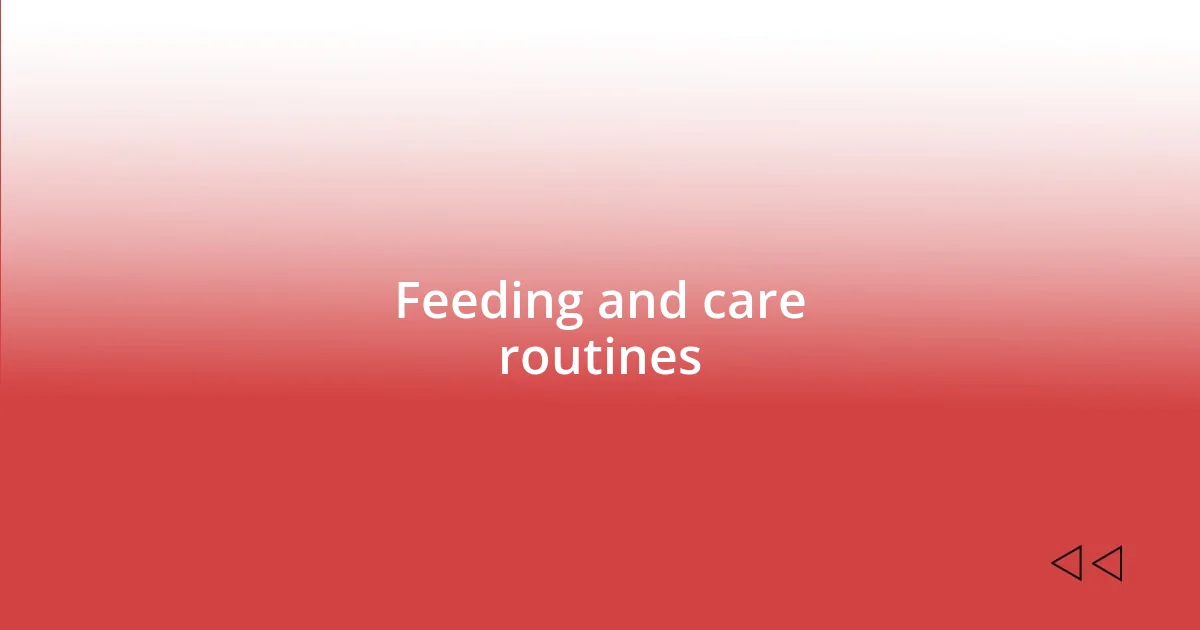
Feeding and care routines
Feeding my vivarium inhabitants was a learning curve that I didn’t anticipate. I initially thought it would be as simple as tossing in some food and walking away. However, I quickly learned that a well-planned feeding routine is crucial. I remember one evening feeling a twinge of panic when I realized I’d overestimated how much my frogs could eat. Watching them struggle with the overflow was a lesson in moderation. I’ve come to understand that portion control is vital; not only does it prevent waste, but it also ensures that everyone gets their fair share.
Then, there’s the variety in their diets that I hadn’t fully appreciated at first. I was surprised to discover that my little reptiles thrived on a mix of live insects, fruits, and even specific plant matter. In my early days, I swung between being a meticulous planner and a last-minute decision-maker. I vividly remember a particularly frantic grocery run, hunting down crickets, and feeling like a wildlife chef on a mission! The joy in seeing my pets happily devouring what I provided taught me about the importance of a balanced diet. Not only do I think about their needs, but I also ponder how each meal impacts their health and vitality.
Lastly, maintaining cleanliness in the feeding area and ensuring fresh water is non-negotiable. I learned this after a couple of unfortunate incidents with stubborn algae and bacteria growth. The first time I saw my tank’s ecosystem struggling, my heart sank. It prompted me to create a simple routine for cleaning and replacing water regularly. Trust me, it’s worth the effort—there’s a certain satisfaction in knowing I’m doing my part to give my vivarium the best chance at thriving. And honestly, who wouldn’t want to witness the vibrant, lively interactions that come when everything is in harmony?
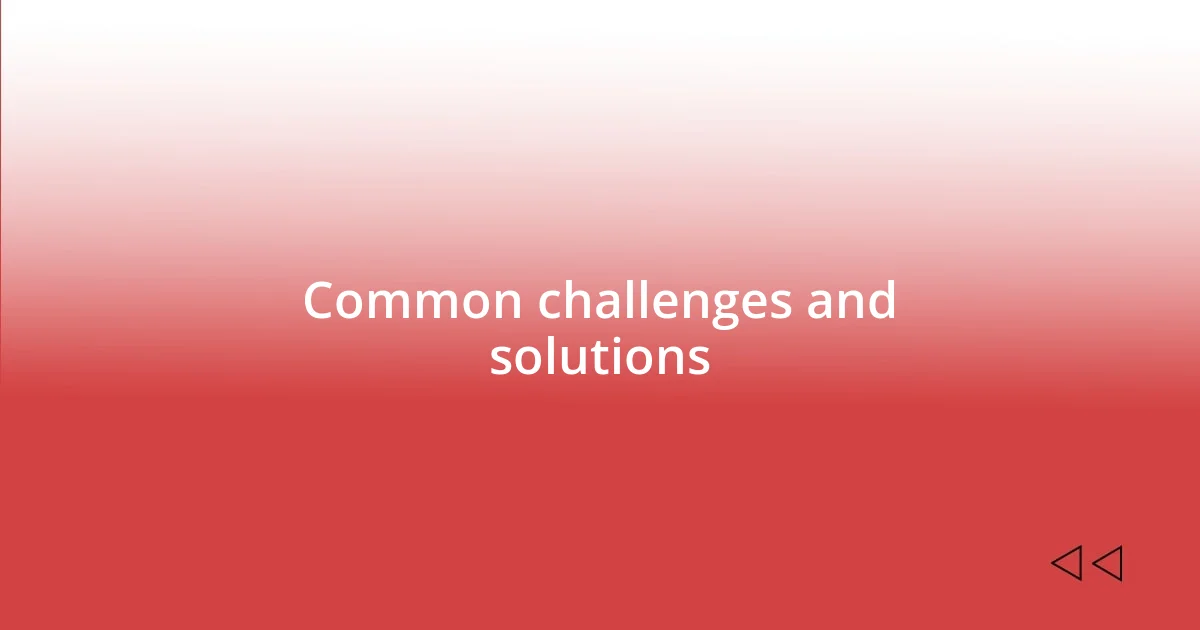
Common challenges and solutions
Managing unexpected pests was certainly a challenge I hadn’t anticipated. I remember my shock one afternoon when I found tiny mites scuttling around my plants, as if they were gatecrashers at a party. It felt overwhelming, but I learned quickly that not all insects signify doom; sometimes, it’s about understanding the role each one plays. Implementing preventive measures—like introducing beneficial predators—became a game changer. Have you ever had to evict an unwelcome guest from your space? I assure you, understanding your vivarium’s ecosystem helps you maintain peace.
Another hurdle was balancing plant health with the needs of my animals. In the beginning, I often overlooked that some plants could be toxic to my frogs and reptiles. I still remember a panicked moment, standing at the pet store, reading the labels in a frantic attempt to ensure I wasn’t bringing home something harmful. Making educated choices about plant species became crucial; not only did my animals thrive, but I felt a sense of accomplishment knowing I was creating a safe home for them. Who knew that a little research could lead to such peace of mind?
Lastly, establishing a consistent maintenance schedule has been vital for keeping everything in check. At first, I’d find myself randomly cleaning or adjusting things whenever I felt like it. That approach led to some forgetful moments—like the time I let the water filter go too long without a check-up, only to end up with murky water. I realized that predictable routines not only ease my mental load but also contribute to the overall health of the vivarium. Isn’t it rewarding when a simple strategy contributes to a healthier and happier ecosystem? In this hobby, the more organized I became, the more fulfilling my experience turned out to be.
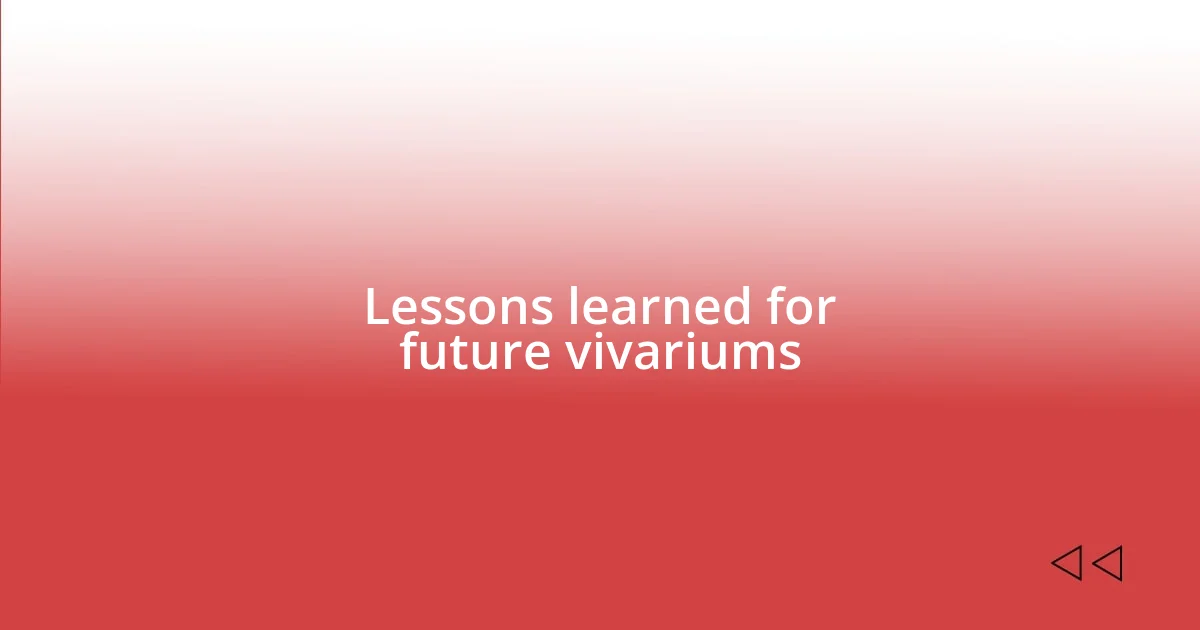
Lessons learned for future vivariums
One of the most significant lessons I’ve learned for future vivariums is the importance of patience during setup. In my eagerness, I was tempted to rush the process, thinking that adding creatures immediately would bring instant joy. However, I soon realized that a hastily assembled environment can lead to stress for both me and my pets. I remember the agonizing wait after introducing beneficial bacteria to establish a healthy ecosystem—it felt like watching paint dry! But now, I genuinely appreciate that taking time to layer the elements thoughtfully ensures a stable home for all.
Another takeaway is the power of observation. Early on, I was so focused on following care guides that I neglected to pay close attention to the subtleties of my vivarium. I can recall a time when my chameleons appeared dull in color, and it struck me how little I’d noticed their behaviors and interactions. By simply sitting quietly and observing, I learned to tailor changes in their environment based on their cues. This deepened my connection with them, as understanding their needs became a shared journey rather than a checklist.
Lastly, I found that connecting with fellow enthusiasts through communities can be invaluable. There were moments of confusion, like when I tried to identify which nutrients my soil was lacking. At times, I felt like an isolated island, but joining a local forum opened a world of insights and support. Hearing others share their stories—even the mishaps—made me feel less alone in my challenges. Doesn’t it resonate with you how shared experiences can turn apprehension into empowerment? Through collaboration and shared wisdom, I now approach my vivarium projects with greater confidence and enthusiasm.








